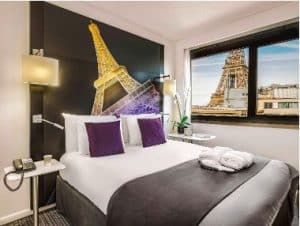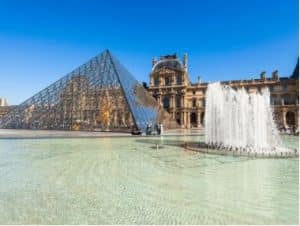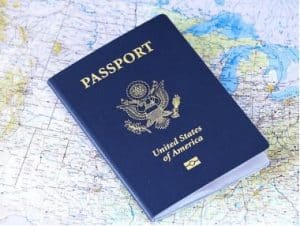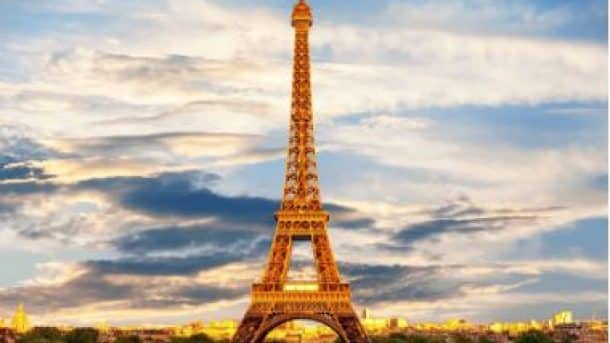Why will you find it so appealing? Since it’s Paris, naturally. From Monet and Debussy to Sartre and Coco Chanel, this is the City of Light and Love—where people live, love, argue, and create. You come here to eat, wander, and take in some of the best historical sites and museums in the world. It’s crazily romantic, endlessly scenic, challenging to traverse, and always unexpected. There is the iconic Eiffel Tower, the Musée D’Orsay with its plethora of artwork, the Louvre with its endless halls of masterpieces, and Notre Dame de Paris, one of the most stunning cathedrals in the world (now closed due to a fire in 2019).
Then there are the vastly different neighborhoods, such as the chic 8th arrondissement boulevards, the gritty, trendy 11th arrondissement Belleville, or the maze-like network of charming streets that radiate from the white dome of Sacré-Coeur in Montmartre. Paris isn’t regarded for being the greenest city, but its lovely formal gardens, such Jardin du Luxembourg, a lush 25-hectare playground, and Jardin des Tuileries, which are the ideal route between the Louvre and the Place de la Concorde, provide a pleasant summer respite. You can sleep in some of the most opulent hotels in the world, eat like a king, sightsee till you drop, and shop until your credit card melts—all for a price. Paris is the location. You will absolutely adore it.
How to Proceed
The massive crowds and lengthy lines have been replaced by online reservations and staggered access, which helps make visiting the Eiffel Tower somewhat more pleasant if you do decide to check it off your list. A less crowded and more spectacular perspective, including with the Eiffel Tower itself, may be seen atop one of the city’s tallest skyscrapers, Tour Montparnasse, which has a 56th-floor public observation deck.The Louvre is a must-see, but be prepared for throngs of people gathered around the main attraction—the Mona Lisa.Wednesday and Friday late-night openings are the quietest; purchase your tickets online in advance.
Despite having a sizable collection of masterpieces, the Musée D’Orsay, housed in a former belle époque train station, never seems quite so bustling.
Get your fill of impressionism here; you’ll find tons of works by Van Gogh, Monet, Manet, Degas, Renoir, and others. Visit the Musée de l’Orangerie to see more of Monet, whose stunning oval-shaped chambers contain his Water Lilies. The surrealistically gorgeous Fondation Louis Vuitton, designed by Frank Gehry, is home to major contemporary exhibitions. It is located in the Bois de Boulogne.
Until its complete refurbishment in 2023, the Centre Pompidou will remain closed, but in the interim, you may still explore its interior design and take a ride on the glass-enclosed escalator. You should also take a closer look at the Arc de Triomphe, where you may ascend to the summit to witness the unique driving styles of the French city. Secret culinary Tours provides walking tours of different neighborhoods that include lesser-known cheese stores, chocolatiers, cafés, and wine merchants. These trips offer an insider’s perspective on the Paris culinary scene. Alternatively, take a bike trip with Paris à Vélo or Paris Bikes trip to explore the sights.
Where to lodge in Paris

For intense touring, choose the 1st arrondissement, which is close to Notre Dame, the Musée D’Orsay, and Saint-Germain. It is also home to some of Paris’s major attractions, such as the Louvre and the Jardin des Tuileries. As such, hotels are upscale; one such hotel is Le Meurice, which has been a prominent presence on Rue de Rivoli since the 1800s. The vicinity of the Arc de Triomphe and Champs Elysées, home of the Four Seasons Hotel George V and Le Bristol, as well as the most well-known grandes dame in the city, is equally affluent.
Although Montmartre’s winding alleyways and charming village atmosphere make it a great choice for romantic getaways, Pigalle, with its bars, clubs, and mid-range hotels like the Grande Pigalle, has a gritty, more metropolitan ambiance.
Right Bank’s The Marais is still the best place to find hip galleries, chic shops, and exciting eateries.
Literary types would relish tramping about Saint-Germain on the Left Bank, which was once frequented by Sartre, de Beauvoir, Miller, Hemingway, and other notable figures. Oscar Wilde passed away in L’Hotel, which is conveniently close to Jardin du Luxembourg. Speaking about literary genres, Shakespeare and Company, the most well-known bookstore in Paris, as well as the Sorbonne are located in the Quartier Latin. You’ll need to venture a bit outside of center Paris to get the greatest low-cost hotels in the area; Mama Shelter and Generator Paris are two excellent choices.
Consumables in Paris
In a city with nearly 100 Michelin stars, it would be difficult to have a poor meal in Paris, even with the abundance of glossy, photo-filled menus supplied by every tourist trap you pass. The vicinity of the Champs Elysées is home to some of the most well-known upscale haute cuisine establishments, such as Pierre Gagnaire and Le Cinq in the Four Seasons Hotel George V. If you’re looking for something more subdued, the Marais is home to a variety of inexpensive, upbeat pubs and restaurants, such as L’As du Fallafel, where you’ll have to wait in line for their flavorful falafel wraps, and Breizh Café, which is well-known for its galettes and crepes.
Naturally, a large portion of the pleasure of dining out in Paris lies in its traditional bistros and brasseries, where stern white-aproned servers prowl around with chalkboard menus, and your coq au vin or steak frites are best enjoyed with a carafe of good house red. A popular spot for many years is La Fontaine de Mars, where tables overflow onto the cobblestone sidewalk just a short walk from the Eiffel Tower. Meanwhile, Café de la Paix, located on Place de l’Opéra, is a national landmark that is well-known for both its brasserie cuisine and its gilded, frescoed interiors, which are undergoing renovations.
The Hemingway and Picasso-famous Les Deux Magots in Saint-Germain may be crowded with tourists, but it’s still a charming place to have a café crème outside in the sun.
The equally well-known Café de Flore is located directly nearby. Ladurée has several locations throughout the city that provide its famous macarons in pastel colors. For a unique twist on the same decadent dessert, visit Christophe Roussel in Montmartre.
How to Avoid missing in Paris

Markets abound in Paris, ranging from the gastronomic delights of the diminutive Le Marché Des Enfants Rouges in the Marais, the oldest covered market in the city, to the upscale antiques and trinkets of the Marché aux Puces de Saint-Ouen. The latter, located to the north of the city, bills itself as the world’s biggest flea market, a maze of booths, corridors, and marketplaces offering just about anything secondhand you could possibly want. Hug ferociously.
The 150-year-old La Samaritaine Paris Pont Neuf department store, which is currently owned by the LVMH company, will open for high-end shopping in the summer and feature over 600 fashion labels, a sizable new beauty floor, a Mauro Colagreco restaurant, and a Cheval Blanc Hotel. Located next to the Seine, the Musée du Quai Branly is a relatively unknown museum that houses about 3,000 pieces of indigenous art from Oceania, the Americas, and Africa. On a hot day, it’s worth making the trek to the slightly more pastoral Parc des Buttes-Chaumont in the 11th arrondissement. Pack a picnic, then climb up to the Temple de la Sybille for views of the city.
Be informed before you leave.
You will, of course, require euros. The easiest approach to understand the layout of the city is to see the sights on foot as a large portion of the center is walkable. It’s not too important to understand the specifics of how the arrondissements operate; in essence, they radiate outward from the center in a clockwise direction, thus the 2nd arrondissement connects to the 9th, for instance. It’s unclear.
You can reach just much anywhere with the Metro, making it an affordable and simple mode of transportation. Purchase a Navigo Easy card (similar to the Oyster card in London) at any Metro station prior to your trip, then top it off as needed. In general, public transportation is safe, but beware pickpockets, just like in any large city. The Bateaux-Mouches, the glass-encased tourist boats that ply the Seine, are a terrific way to see the city and a big hit with kids, but Parisians avoid them like the plague.
Frequently Asked Questions
When is the ideal time to travel to Paris?
Both the spring (March–May) and fall (September–November) seasons provide nice weather and moderate crowds. With its beautiful weather, summer (June–August) is the busiest travel season. However, be prepared for more crowds and pricier pricing. With its festive decorations and reduced crowds, winter (December to February) can be pleasant, however certain attractions might have shortened hours.
Does entering France require a visa?

For visits under ninety days, citizens of the majority of EU member states, the US, Canada, Australia, and New Zealand are not required to have a visa. Before you go, make sure you are aware of the most recent visa regulations specific to your country.
How much does it cost to travel to Paris?
Depending on your preferred level of luxury, Paris may be an affordable or expensive travel destination. Dining and lodging are the largest outlays.If you want to save money on public transportation and attraction admission, think about getting a Paris Pass.





